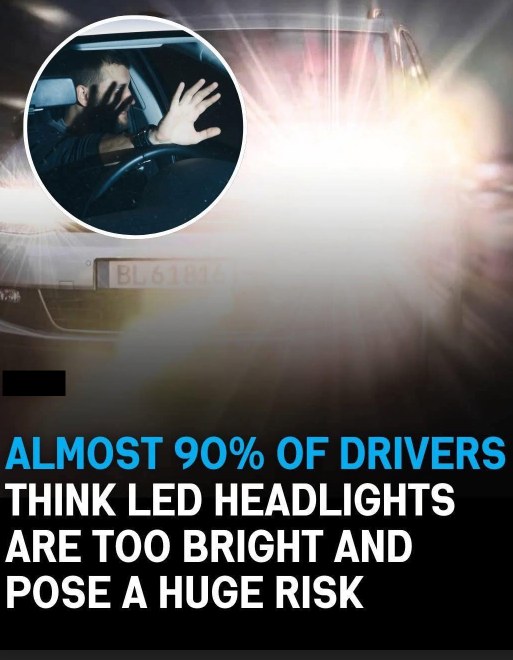LED headlights have quickly become a standard feature in today’s vehicles, widely recognized for their stylish look, long lifespan, and exceptional energy efficiency. Automakers have embraced this technology as a step forward in both design and performance, replacing older halogen bulbs with more advanced lighting systems.

These new lights not only enhance the appearance of modern vehicles but also offer better illumination for drivers, helping them see further down the road, especially at night. However, despite these advantages, a growing number of drivers are voicing serious concerns about the impact of LED headlights on road safety. In fact, nearly 90% of drivers report that LED headlights are simply too bright, creating a glare that can be distracting and even dangerous for oncoming traffic. This widespread unease has sparked a national conversation about how to balance the benefits of cutting-edge automotive technology with the basic need for safety on shared roadways.
One of the key complaints surrounding LED headlights is their intense brightness, which can momentarily blind or disorient drivers approaching from the opposite direction. This temporary vision impairment is especially risky during nighttime driving or in adverse weather conditions, when visibility is already limited. Older drivers, and those with more sensitive vision, often experience even greater difficulty when faced with the piercing glare of these lights. The sharp, focused beams of LED systems may offer clear views for the driver using them, but for others on the road, the light can feel overwhelming and unsafe. As this concern becomes more widespread, it raises the question of whether these high-tech lights are actually improving road safety or unintentionally making it worse.
The rise of LED headlights has been driven by several appealing features. Compared to halogen bulbs, LEDs consume far less energy by converting electricity directly into light with minimal heat loss. This efficiency makes them more environmentally friendly and cost-effective in the long run. In addition, LEDs tend to last significantly longer than traditional bulbs, reducing the frequency of replacements and maintenance. Their ability to produce a crisp, white light allows drivers to see objects and road signs more clearly, which can be especially helpful in poorly lit or rural areas. These benefits have made LED headlights attractive to both car manufacturers and consumers seeking modern, high-performance vehicles. However, the unintended consequences of this technology cannot be ignored. The way LED headlights are installed and aimed plays a huge role in their overall impact.
If they are not properly aligned or are mounted too high, the light can hit other drivers directly in the eyes, increasing the risk of accidents. Inconsistent manufacturing standards and the lack of strict regulations around headlight brightness have only added to the problem, leaving many drivers frustrated and concerned. Some have even chosen to limit their nighttime driving to avoid the discomfort caused by oncoming LED glare. As awareness grows, safety advocates and transportation authorities are beginning to explore potential solutions. One promising option is the development of adaptive headlight systems, which automatically adjust the intensity and direction of the beams based on driving conditions and the presence of other vehicles. These systems, while currently limited to more expensive models, offer a glimpse into how lighting technology could evolve to benefit everyone on the road. Another idea involves updating regulations to set clearer standards for headlight brightness and beam angles to reduce the risk of glare without compromising visibility. Until such measures are widely implemented, the debate over LED headlights will likely continue. While innovation in automotive design is important, it must be matched with a commitment to safety and consideration for all drivers. As technology continues to evolve, automakers and regulators have a responsibility to ensure that progress does not come at the cost of comfort and safety. LED headlights may represent the future of vehicle lighting, but if the majority of drivers feel they’re too intense, then it’s time to rethink how that future should look.





